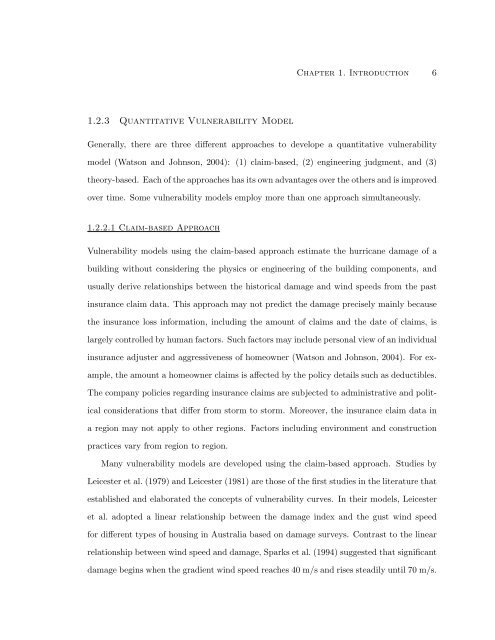Wind Hazard Risk Assessment and Management for Structures
Wind Hazard Risk Assessment and Management for Structures
Wind Hazard Risk Assessment and Management for Structures
Create successful ePaper yourself
Turn your PDF publications into a flip-book with our unique Google optimized e-Paper software.
1.2.3 Quantitative Vulnerability Model<br />
Chapter 1. Introduction 6<br />
Generally, there are three different approaches to develope a quantitative vulnerability<br />
model (Watson <strong>and</strong> Johnson, 2004): (1) claim-based, (2) engineering judgment, <strong>and</strong> (3)<br />
theory-based. Each of the approaches has its own advantages over the others <strong>and</strong> is improved<br />
over time. Some vulnerability models employ more than one approach simultaneously.<br />
1.2.2.1 Claim-based Approach<br />
Vulnerability models using the claim-based approach estimate the hurricane damage of a<br />
building without considering the physics or engineering of the building components, <strong>and</strong><br />
usually derive relationships between the historical damage <strong>and</strong> wind speeds from the past<br />
insurance claim data. This approach may not predict the damage precisely mainly because<br />
the insurance loss in<strong>for</strong>mation, including the amount of claims <strong>and</strong> the date of claims, is<br />
largely controlled by human factors. Such factors may include personal view of an individual<br />
insurance adjuster <strong>and</strong> aggressiveness of homeowner (Watson <strong>and</strong> Johnson, 2004). For ex-<br />
ample, the amount a homeowner claims is affected by the policy details such as deductibles.<br />
The company policies regarding insurance claims are subjected to administrative <strong>and</strong> polit-<br />
ical considerations that differ from storm to storm. Moreover, the insurance claim data in<br />
a region may not apply to other regions. Factors including environment <strong>and</strong> construction<br />
practices vary from region to region.<br />
Many vulnerability models are developed using the claim-based approach. Studies by<br />
Leicester et al. (1979) <strong>and</strong> Leicester (1981) are those of the first studies in the literature that<br />
established <strong>and</strong> elaborated the concepts of vulnerability curves. In their models, Leicester<br />
et al. adopted a linear relationship between the damage index <strong>and</strong> the gust wind speed<br />
<strong>for</strong> different types of housing in Australia based on damage surveys. Contrast to the linear<br />
relationship between wind speed <strong>and</strong> damage, Sparks et al. (1994) suggested that significant<br />
damage begins when the gradient wind speed reaches 40 m/s <strong>and</strong> rises steadily until 70 m/s.
















